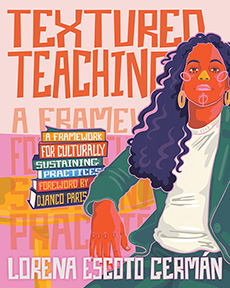Texturing Culturally Sustaining Practices
Textured Teaching: A Framework for Culturally Sustaining Practices
By Lorena Escoto Germán
(Heinemann, 2021 – Learn more)
Reviewed by Katie Durkin

In this spirit, I have sought out professional texts like Textured Teaching: A Framework for Culturally Sustaining Practices. It’s the book I wish I’d had at the beginning of my career, as it has helped me rethink how I can create space in my classroom for love, community, social justice, truth, and knowledge.

As she began to develop the Textured Teaching framework, Germán asked questions about connection, engagement, positive impacts on students, and how she could use the content of her teaching to guide them in relating to a global community.
Germán summarizes her purpose in creating the Textured Teaching framework as meeting “the need [for students] to develop a sense of cultural proficiency and deconstruct the harmful practices our society has socialized us all into” (p. xvii).
The first chapter of Textured Teaching helps readers understand what they will need to know to comprehend the text and why teachers need to include this framework in their classroom. Germán discusses the values of social justice – love, community, justice, truth, and knowledge – and how we can assure we are doing the work it takes to establish them in our classrooms.
By committing to the framework of Textured Teaching, teachers will achieve culturally sustaining pedagogy, Germán believes. She ends the chapter by asking teachers to think about their own classrooms, as well as their positionality. Germán calls upon teachers to make students and their identities and communities a priority.
Textured Teaching Is Student Driven and Community Centered
Chapter two begins with a focus on how teachers and students can unpack identity in the classroom. Germán asks teachers to think about “The Land Work” by acknowledging the history of the indigenous people who inhabited the land where the school is. She advocates doing this work with students to acknowledge the pain and resiliency of these first nations and to help them develop their social consciousness.
Germán also advocates for teachers to partner with parents and community organizations – suggesting actions such as sending out a monthly newsletter – to keep these stakeholders aware and informed about the textured work taking place the classroom.
She also provides strategies for the classroom, which involve thinking about the physical and wall space, the texts to include in classroom libraries, and specific student needs. I found all these suggestions to be incredibly helpful in thinking about the application of this part of the Textured Teaching framework.
Textured Teaching Is Interdisciplinary
In this chapter Germán explains the three steps to interdisciplinary teaching within the Textured Teaching framework. First, teachers should use beginning lessons in a unit to demystify and destigmatize any controversial topics or definitions that will be covered in the unit. Germán explains that by doing this work at the beginning of a unit and addressing issues head-on, students and teachers will create more opportunities for conversation in a safe space.
The second step to interdisciplinary teaching is background building and research. The teacher guides students to research topics that relate to the books they are reading. This work includes creating small research groups where students can collaborate with others to learn about a topic, share their learning, and take ownership of the knowledge gained.
Interdisciplinary teaching within the Textured Teaching framework ends with supplementary texts that will expand students’ critical thinking beyond the primary text they are reading. Germán suggests ways to use art, math, science, or performing arts to help students find connections between their reading texts and other topics.
She includes multiple visuals and examples from her own teaching in this chapter as well as tables of specific texts teachers can use in the classroom to promote research, demystify, destigmatize, and expand understanding,
Textured Teaching Is Experiential
The fourth chapter explains how Textured Teaching is experiential. Germán begins by identifying critical intellectualism as experiential learning, specifically looking at ways to use students’ home communities as resources of learning. She provides guiding questions for educators as well as specific examples of projects and experiences that teachers can transfer to their own spaces.
The chapter ends by asking teachers to be thoughtful and reflective in their use of experiential learning, especially in regards to texts that may contain stories where characters are experiencing hardships.
Textured Teaching Is Flexible
Germån’s final chapter is my favorite. Divided into five parts, this chapter givea teachers ready-to-use strategies to help them create more flexible opportunities for learning.
Germán starts with ideas for flexible discussions – using tools like think-pair share, rotating learning, and philosophical chairs – which allow students to show their thinking in different ways.
She then provides examples of processing sheets teachers can use to differentiate instruction, and ways to help teachers think about out-of-school literacies that will help them get to know their students even better,
The final part of the chapter offers strategies for teachers to be flexible with assessments and grading – two areas of teacher work that often may not seem to invite flexibility. Germán suggests two ways teachers can invite students to show their understanding that work well within her framework. For grading, she builds on the concept of including students in the grading process by having them co-create rubrics.
What I enjoyed the most about this chapter was Germán challenging teachers to think about the difference between classroom management and body management and whether their management practices are mostly about control or truly about helping students grow.
Resources Offered in Each Chapter
At the end of each of the chapters describing the four tenets of Textured Teaching, Germán includes three resources that I found to be especially valuable.
- First, she provides information on the “Cautions and Challenges” for implementing this part of the Textured Teaching framework. She explains what teachers can do to help themselves feel more comfortable, as well as how to have conversations with colleagues about the concepts.
- “Adding a Layer of Texture” is where Germán takes the focus from the chapter a step further to recommend to teachers how they can collaborate with others in their school and the larger community to implement the Textured Teaching framework.
- There is also a page left blank for readers to take notes. Mine are filled up!
These three features enhance the reader’s experience, start us thinking about real-world implementation of the framework, and set the stage for book studies and other steps to begin schoolwide discussions about framework principles
It’s a Quick and Easy Must-Read
Germán easily weaves her personal experiences into her presentation of the Textured Teaching framework, holding our interest as she invites us into a deeper reflection about what it means to grow a culturally sustaining teaching practice.
I found that this text pairs well with another book I read and reviewed for MiddleWeb earlier this year, Identity Affirming Classrooms by Dr. Erica Buchanan-Rivera. Both of these books center students, their identities, and their humanity at the forefront of our professional work. They also give teachers actionable strategies and activities they can implement right away.
Creating Spaces to Center Students’ Needs
I highly recommend this book to teachers, administrators, curriculum coordinators, coaches and others who are looking to create spaces that better embrace the current and future needs of our students.
I also would recommend following Lorena Escoto Germán on Twitter (@nenagerman). After I finished reading the book, I have been able to continue to learn from Germán through her tweets as I work to bring Textured Teaching into my classroom.
Dr. Katie Durkin (@kmerz610) has been teaching English Language Arts to middle school students for over a decade, and currently teaches 7th grade Reading Workshop at public Middlebrook School in Wilton, Connecticut. In 2022 Katie earned her doctorate at Northeastern University, where her research examined the impact of classroom libraries on middle school reading engagement. She was the 2020 recipient of NCTE’s Edwyna Wheadon Postgraduate Training Scholarship.



































